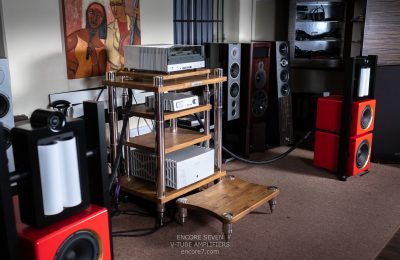- No moving parts, solid build – natural wood and metal
- Deactivation on shakes or any motion other than circular
- Radio transmission, base frequency: 2.4 GHz ISM, channel width: 1 MHz
- Transmitter output power: 0 dBm, receiver sensitivity: 90 dBm
- Total operating time with full charge: approx. 20 hours continuous operation (adjusting volume)
- Remote operations distance, in open space, without any obstacles or barriers: up to 25 metres
- Power supply: single Li-Po 3.6V battery, maximum volume: 4.2 V
- Harging: any 5V USB charger; possibile charging from a computer USB port
- Battery status and battery charge indicator
- Accessories: USB cable
- Dimensions WxDxH [cm]: 11 x 11 x 9,5
- Weight: 1 kg
- Packaging: dedicated box
Encore Seven SYNCHRONICITY
V-TUBE integrated amplifier
The Encore Seven SYNCHRONICITY is the very essence of the EGG-SHELL Prestige series we produced between 2011 and 2021. Instead of several SET (Single Ended Triode) Class A models, differing primarily in output power from 9 W to 18 W, we have constructed a universal push-pull amplifier, which represents Class A for power up to 13 W and reaches a maximum of 40 W per channel. In fact, it is a completely new construction, a design created from scratch, to which we have devoted 2 years of work.
Description and features
The Encore Seven SYNCHRONICITY is an integrated push-pull vacuum tube amplifier. It operates in a pentode circuit in ultralinear mode, producing a maximum of 40 W per channel in Class A/B. For power up to 13 W it represents pure Class A. The amplifier is designed to work with majority of loudspeakers and is recommended for medium to large rooms. Designed and built in a timeless style, it is austere and simple, but at the same time unique and eye-catching. It is designed and handcrafted in Poland.
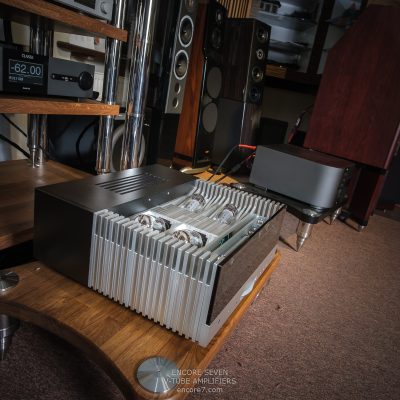
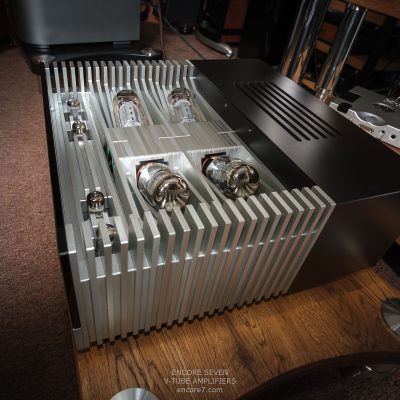
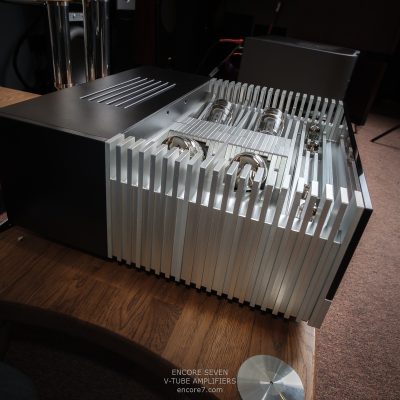
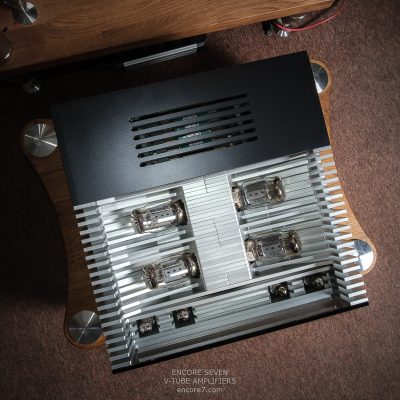
Input stage
It is built on the basis of a constant current draw amplifier (CCDA),which means that regardless of voltage changes (amplification of the input signal) the amount of current drawn from the power supply remains constant. This configuration prevents power supply voltage surges, which could adversely affect the quality of the input signal amplification. As ECC88 tube (6DJ8) is used in the circuit, it essentially lowers the output impedance of the power stage and has a major impact on optimal operation with phase inverter.
Phase inverter and control
The KT88 power tube phase inverter and control stage circuit are based on a differential amplifier whose topology allows direct coupling to the input stage. This solution offers signal feeding without the need for a coupling capacitor. The idea of the amplifier is to keep the signal path as short as possible, hence the use of a differential amplifier (on 12BH7 tubes), which, in addition to the function of matching the phase of the signal to the output tubes, also gives an appropriate level of amplification of this signal. This eliminates the need for an additional control stage.
Output stage
The need for a coupling capacitor in the signal path has been limited to one piece, which is located between the differential amplifier and the KT88 power tubes. The output stage is a classic push-pull amplifier operating in a pentode circuit in ultralinear mode with automatic polarization (so-called autobias). The use of autobias not only simplifies the operation of the amplifier after tube replacement or during tube wear, but also simplifies the structure of the power supply circuit. This has made it possible to use better components at critical points in the power supply unit.
Anode power supply
The anode power supply incorporates a semiconductor rectifier that supplies voltage to the capacitor bank, which consists of Miflex polypropylene and Nichicon electrolytes of a total capacity of over 1,200 uF. All decoupling and filter capacitors found in the signal circuits are exclusively Miflex polypropylene capacitors. Apart from the anode power supply bank, electrolytes were only used in the control and logic circuits and in the tube glow circuit.
Key components used
Power supply and output transformers – Ogonowski (manufactured to order). Chokes – Hammond. Resistors – Vishay and Kiwame. Capacitors – Miflex and Nichicon. Gold-plated RCA signal and speaker sockets – CMC. Ceramic tube sockets – EIZZ. Motorised volume potentiometer – ALPS.
Gyroscopic remote control
An innovative remote control with an unprecedented appearance and mode of operation is another bold idea that is changing previous standards in the audio world. The volume control has no moving parts. It is enough to twist it left or right to change the volume. When turned upside down, the LED indicators for battery status and charging indication become active. The charging socket and switch are located at the bottom. This gives us a visually homogeneous object without any buttons or other controls.
Construction
The amplifier is constructed in a modular way so that it is easy to service. All components can be easily accessed, whereas the use of space inside is optimal. To build it, we used durable materials such as steel, aluminium and glass. All components are machined on CNC digital machines and finely finished.
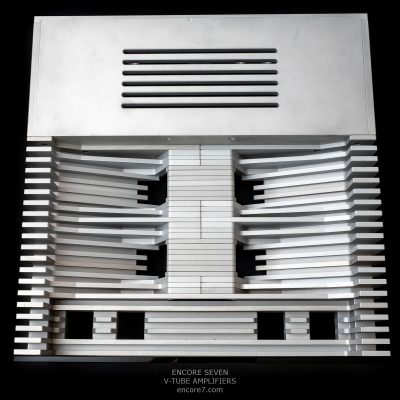
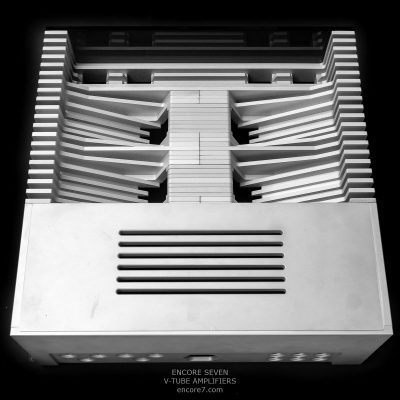
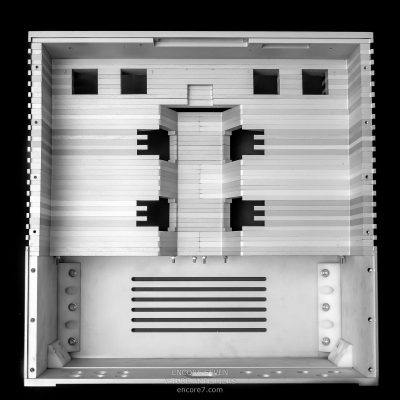
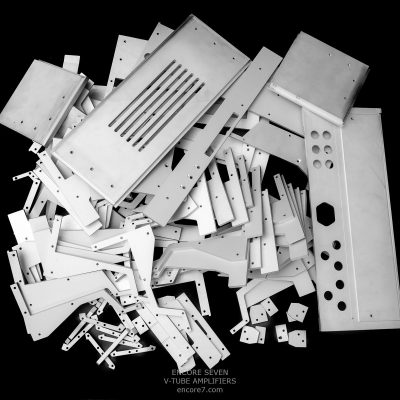
Chassis
The supporting structure (chassis) is constructed from thick powder-coated sheet. It consists of two separate parts – front and rear. We made sure of the high quality of the smallest details, such as the screws connecting the elements. The transformers are suspended on flexible pads to minimize the transmission of vibrations to the PCBs and tubes. The chassis is a ‘self-supporting’ structure, with the outer casing being merely an overlay. This makes the amplifier easy to assemble.
Radiator
The radiator is called the outer casing. Indeed, this is the role it fulfils. It consists of approximately 100 aluminium sheets 6 and 8 mm thick. Each is precisely manufactured and individually painted. The whole is bolted together with twenty strings, creating a uniform block of a unique shape, embodying the idea of the V-TUBE design, the inclination of the power tubes.
Front
The front is fitted with a 6 mm thick glass panel, easily assembled on strong neodymium magnets.
Controls
The main and most distinctive control is the large, horizontal volume wheel. It is precisely seated on the axis of a motorized Alps potentiometer and supported at a second point by a bearing, which ensures stability of position. The relay activation buttons are responsible for changing the sound source. The main switch starts the amplifier in two steps (so-called ‘soft start’), first giving the glow tube voltage and, after a few tens of seconds, the anode voltage, which is very desirable as it has a positive effect on the life span of the tubes.

Specification
Amplifier
- Type: Integrated vacuum tube stereo amplifier, class A, A/B
- Push-Pull ultralinear pentode
- Output power: 2 x 40 W / 4 Ohm
- Impedance: 4-8 Ohm
- Frequency response: 15 Hz – 22 kHz (+/-1 dB)
- Distortions (Pmax): <3%
- Input sensitivity (Pmax): 300 mV
- Input impedance: 100 kOhm
- NFB (Negative Feedback): 0 dB (brak)
- Power tubes: 2 x KT88 / channel
- Inputs: 3 x RCA
- Volume control: potentiometer
- Remote control: yes (volume)
- Dimensions WxDxH [cm]: 44 x 46 x 19
- Net weight: 35 kg
- Weight with packaging: 40 kg
- Packing: Transport case




